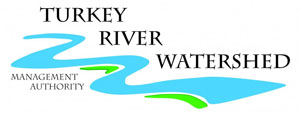Driftless Waters
Dave Vetrano, retired Wisconsin DNR fisheries biologist, has more than 32 years of cold water stream management in the Driftless Region. His presentation, given to our neighbors, the Basin Alliance for the Lower Mississippi in Minnesota (BALMM), gives a short history of land use changes in the Driftless Area since the time of European settlement, and then discusses the effect those changes have had on the coldwater streams.
“In well managed grazing systems, soil erosion, manure, pesticide and herbicide runoff is reduced to almost zero.”
Because the last glaciation did not affect this area, there is no drift, and therefore no natural lakes but many rivers and streams. In the 1820s when European settlement began, the landscape was prairie and oak savanna. Fires were set by Native Americans to do managed grazing. The steep terrain had springs and clear, deep streams with brook trout. Logging was the first industry, and it boomed in the 1830s and 1840s for building homes and other structures and as a source of fuel. Agriculture took hold in the 1850s with the use of the moldboard plow. The loess soils were fertile but very fluid when wet. Wheat dominated the landscape in the 1860s and 1870s. Land was $2/acre and wheat sold for $1/bushel. In the 1880s, the dairy industry began and it continues as the main industry today. Grazing of the hillsides led to compaction and no vegetation which caused rill erosion.
Wheat dominated the landscape in the 1860s and 1870s. Land was $2/acre and wheat sold for $1/bushel
The row cropping technology that was brought with the settlers was not appropriate for the area and climate. Headcutting occurred and the sediment filled in the valley floors. Flash flooding was common by 1900 due to the compaction of the hillsides. Erosion was calculated to be 1.8 million tons/year in the 1930s. Sediment filled the valleys to a depth of 12-15 feet. The deep, cold streams became shallow and wide, which increased temperatures changing the fish populations from trout to other species like redhorse.
Farmers petitioned the federal government for help, and the soil conservation practices that are so common today were perfected. The Coon Valley, WI landscape had contour strips, terraces and other practices. The Depression in the 1930s led to the CCC and WPA which built many conservation structures. In 1958, there were dire predictions that trout would be forever lost from the region. Public Law 566 led to the construction of water retention structures, and vegetation began to take hold in the streams because it wasn’t being scoured out every year. The streams began downcutting through the sediment to the parent material, but there was still a lot of lateral movement. LUNKERS (Little Underwater Neighborhood Keepers Encompassing Rheotactic Salmonids) were created by Vetrano and WI DNR staff to provide trout habitat.
The 1985 Farm Bill contained provisions for CRP and cross compliance so that any subsidy recipient had to follow a conservation plan, both of which created a shift in water quality and the fisheries. Base flows increased due to increased infiltration, temperatures decreased, water cress increased, flash flooding decreased, and adult carryover of brown trout increased leading to natural reproduction. In the late 1980s, anglers from outside the area began to discover the resource.
Advances in GIS, increased citizen monitoring, the economic impact of the fishery and instream and riparian habitat restorations are all factors in the comeback of the brook trout. Fish transfers were done in the 1990s with the transfer of 250 pairs that were measured, weighed, and fins clipped to track survival. It was found there was better survival with wild trout stock. A 1994 study showed the fishery provided $190,000 in revenue to the region and 4000 trips per year to two streams. That increased to $1.2 million in 1995 and 8,800 trips per year (1000 cars from 14 states). In 2011, the fishery is estimated to bring more than a billion dollars to southeast Minnesota. Some of the old issues are still here, though: 85% of instream sediment is from eroding stream banks, and there is 8-10 feet of legacy soil in the stream valleys. There has been a return of “up and down” farming.
Hillside grazing is driven by Wisconsin use value assessment which taxes ag land at lower rates. Woods that aren’t grazed get taxed as recreational land so they are grazed to qualify for the ag land rate. Gullies and headcutting are sometimes seen. Feedlots can be a direct conduit for contamination to get into streams. Operators can be fined $26.25 per fish killed. Building sites also have inadequate erosion control. In well managed grazing systems, soil erosion, manure, pesticide, and herbicide runoff is reduced to almost zero. Cheese made from milk from grass fed cows has a very desirable taste, which is a big potential market. Organic Valley Dairy has created over 600 jobs, and most of their milk is from grass fed cows. The economic, social and environmental are all intertwined.
From: BALMM Meeting Minutes, Oct 24, 2012
